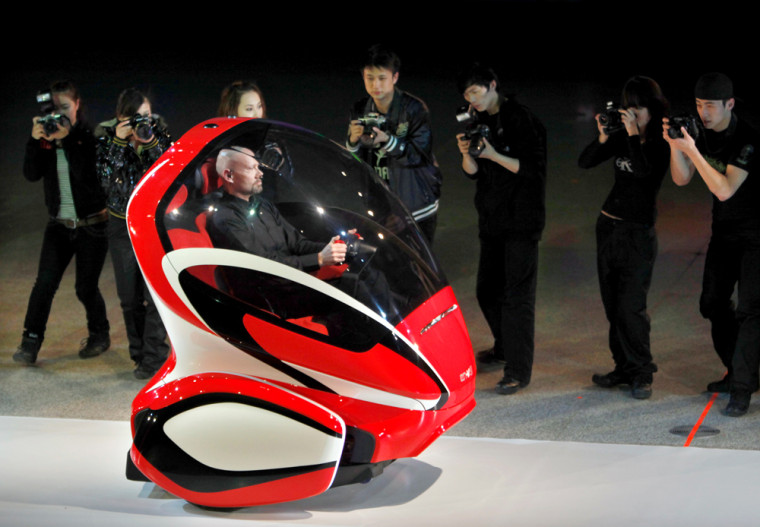It's not quite as foldable as the space vehicle that cartoon figure George Jetson pops into his briefcase as he bops into the office.
But the EN-V concept car, GM's "automobile solution" for the future, just might fit into an apartment foyer.
General Motors and its Chinese partner SAIC will showcase the "Electric Networked-Vehicle" launched Wednesday in their joint pavilion at the Shanghai Expo, which opens May 1 and runs for six months.
The EN-V, pronounced "envy," is GM's latest effort to burnish its credentials as a future-focused, environmentally friendly company and shed its image as the bastion of the gas guzzling Hummer. The automaker is in the process of winding down Hummer after a deal collapsed to sell it to a Chinese heavy equipment maker.
GM is not alone in viewing China as the ultimate landscape for tiny urban vehicles. Daimler introduced its Smart ultracompact here in 2008, though few of them can be seen yet on Shanghai streets.
The two-wheel, two-seater EN-V, which looks something like an oversized vacuum cleaner, is not just about making vehicles small, lightweight and emission-free, the company says.
"What we're talking about here is completely redoing the automobile," says Michael Albano, director of product and technology communications at General Motors International Operations — its global headquarters for international business in Shanghai.
With the trunk-less EN-V, GM has jettisoned the traditional "three box" system and gasoline-fueled engine in place of a pure-electric minivehicle meant strictly for city driving. Five fit in the parking space needed for one conventional vehicle, says Kevin Wale, president and managing director for GM China Group.
"GM's vision with SAIC is petroleum-free, emission-free, accident-free and congestion-free," said Wale. "We think we can do that by combining the benefits of electricity and connectivity."
What better a place to suggest such a solution than in smoggy, accident-plagued, traffic congested China, home to 1.3 billion people?
By 2040, GM says, there will be 1.2 billion cars on Earth, and 60 percent of humanity will be living in cities. For megacity countries like China, the explosion in use of conventional automobiles has already turned into a nightmare of smog, jammed roadways, and nonexistent parking.
The 1.5 meter by 1.5 meter (about 5 foot by 5 foot) EN-V appears to build on GM's earlier work with Segway Inc. in developing the PUMA, or Personal Urban Mobility and Accessibility, vehicle. It will use the same types of battery cells as the Segway and the same battery supplier, Valence Technology Inc., said Christopher Borroni-Bird, GM's director of advanced technology vehicle concepts.
With the EN-V, GM proposes to reconstruct the automobile's "DNA."
The EN-V's maximum speed of only 40 kilometers per hour (24 mph) — even now city roads average only 20 kilometers per hour (12 mph) and often less — and other high-tech features reduce the need for heavy, high-stress steel, bumpers, air bags and crumple zones, says Albano.
Apart from its diminutive size and light weight — 400 kilograms (880 pounds) including the passengers — the vehicle would offer drivers the option of "autonomous driving:" letting the car drive itself via an elaborate system of GPS systems, digital maps, roadway and vehicle sensors, cameras and other devices.
"None of this is beyond the technology that exists today," Wale says.
The idea of allowing the car to take over may sound alarming to some, especially given the recalls due to unintended acceleration and other problems with some Toyota vehicles. But GM's experts say there would be fail-safe backups for any electronics and that, properly equipped and in the right setting, vehicles can do a better job than humans at averting accidents.
In theory, EN-Vs could be hitched together to allow drivers to commute to work while finishing up shaving, phone calls or whatever else without endangering fellow road warriors.
But such functions would have to be optional, Wale says.
"We don't want to take the excitement out of driving," he said.
The Shanghai Expo, with its theme of "Better City, Better Life," offers an apt occasion for GM to introduce its vision for a solution to the urban ills growing worse day-by-day thanks to China's craze for cars.
Whether China and its drivers — who seem inordinately fond of big, heavy cars and nearly acrobatic feats of lane switching — would go for this concept remains to be seen.
But GM does have a track record — at least in its distant past — of foreseeing at least some future trends. The GM "Futurama" vision of a superhighway system, introduced at the 1939 New York World's Fair, is said to have inspired the U.S. Interstate Highway System.
"We're looking at solutions for 2030," said Wale.
"We're looking at ways we can recreate the business we're in a way that takes into account the changes in the world since the products we're using today were invented under a different set of circumstances."
